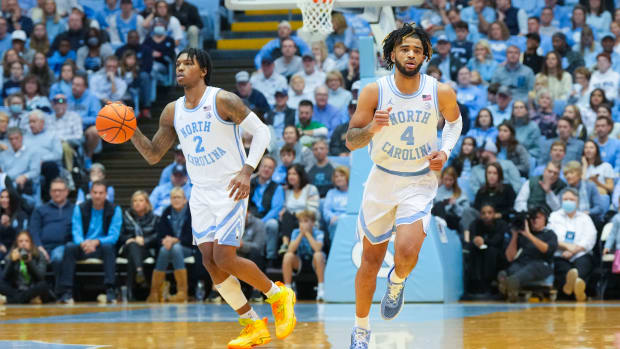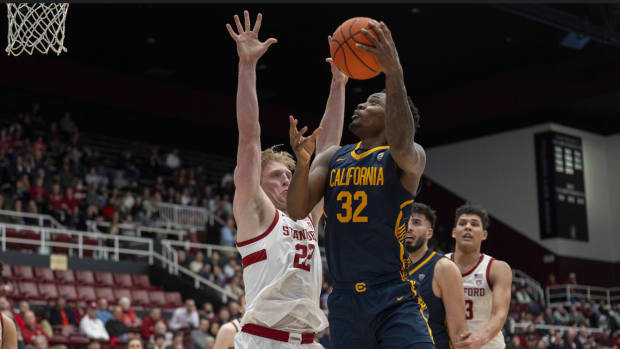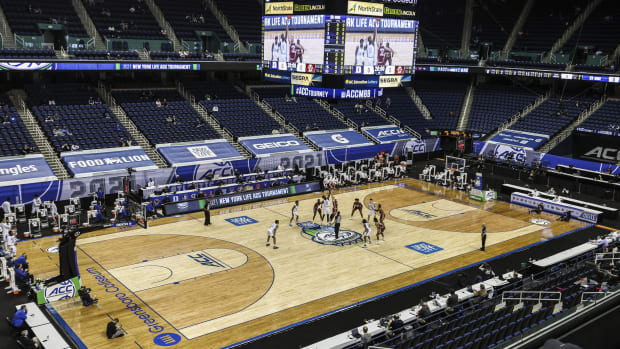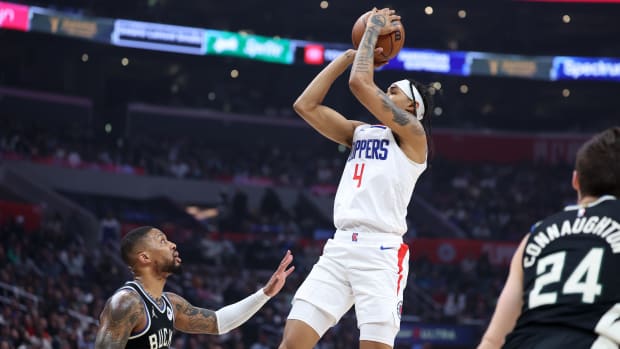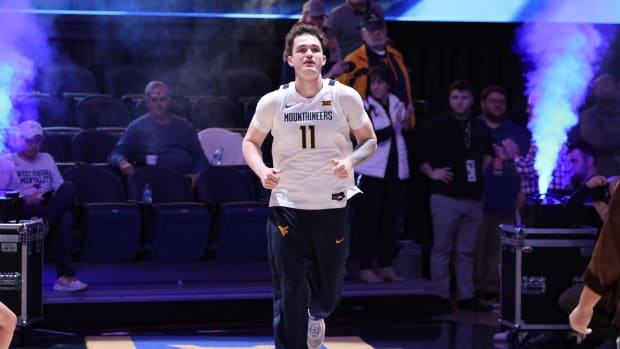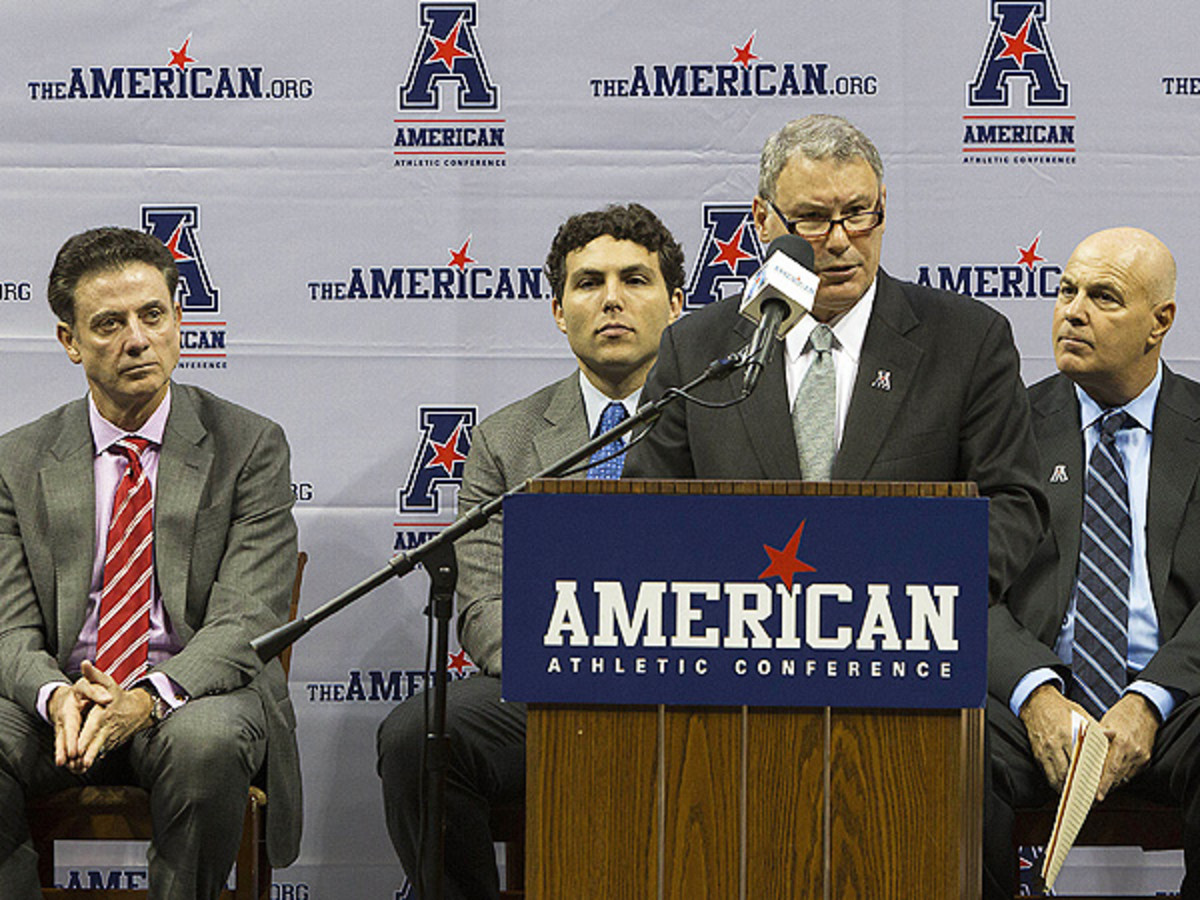
AAC basketball getting balance, breaks at start
Mike Aresco (at podium) likes the balance the AAC has displayed this season. (Lance Murphey/AP)
Mick Cronin does not know precisely what he has until it materializes before his eyes, a minor epiphany then followed by months of paranoia that it will disintegrate at any moment. After a week of preseason practice, Cincinnati’s coach believed he would have his best defensive team ever. When seniors Justin Jackson and Titus Rubles splayed on the floor for loose balls and scrambled all over, and demanded the same from others, it seemed the Bearcats’ spine had set. Cronin swiftly knew what he had and just as promptly began worrying about how long it would last.
On Tuesday, Cincinnati won again, beating Temple and limiting its 25th consecutive opponent to less than 70 points. No one in the American Athletic Conference has figured out the Bearcats, who are 16-2 overall but also 5-0 in their new, nascent basketball home. So on several levels, they are, for the American, a perfect example: Lightly considered or at least beset by questions at the start, only to have things go as well as possible so far.
“It helps you set a tone going forward,” Cronin said this week. “You don’t want people to immediately get down on a league. Any time you’re starting a new business, you want to get off to a good start. Our basketball in the American is definitely getting off to a great start, there’s no doubt about that.”
The American will not lead any debate on the nation’s best basketball conglomerate. With the No. 8 conference RPI, it might strain to enter the conversation. But what felt like a league put together by collecting pebbles washed ashore after conference realignment tsunamis has had most dynamics relating to longer-range viability go its way. Primarily, it’s not a conference dominated by any one program and easily dismissed because of that. And primary to that, it’s not a conference dominated by Louisville, on its one-season layover before landing in the ACC.
The Cardinals’ presence and brand undoubtedly provided valued inventory for a television deal with ESPN and CBS that runs through 2019-2020. Everyone in the league, starting with commissioner Mike Aresco, appreciates that reality. But Louisville will leave behind any NCAA tournament units, which represent revenue delivered to the participating conferences and are calculated based on the number of teams in the tournament and number of games played over a six-year span. And the defending national champions are not running away with the American before they ditch it, at least not yet, a circumstance that would create all sorts of perception issues that theoretically could trickle into recruiting and beyond. The Cardinals are good but not too good, which is the best thing that could happen to this conference.
“I want to be careful how I phrase it, but let me put it this way: It’s good to have no one team dominating,” Aresco said in a phone interview. “It’s good to have a group of really good teams that are obviously going to create a very competitive race. And we want teams that are staying to play well so people feel the league has a good future. That is important.”
Or as even Cronin conceded about a program run by his “main man” Rick Pitino: “It wouldn’t be healthy for one team to dominate for one year and leave. That would be a fair statement.”
In fact, no one is streaking too far ahead of the pack just yet, a relative balance that is necessary even to hint at relevance now and later. Cincinnati is the unexpected leader. Louisville (4-1 in league play) closely trails. Memphis handed the Cardinals their lone AAC defeat but now sits behind them at 3-2 after a Thursday home loss to Connecticut. Meanwhile, Houston and SMU have the same conference record (2-2) as the Huskies. A league’s strengths have to be actually strong, and the American’s five teams in the initial RPI top 40 matched the totals from the Big Ten, ACC, Big 12 and Pac-12.
Louisville and Rutgers exit this summer, the former a greater loss than the latter. (In fact, consider it another morsel of good fortune that the Scarlet Knights can’t be considered to be in extraordinarily better condition as they leave than East Carolina, Tulane and Tulsa, who jump aboard for 2014-15.) But the commitment for the remaining bedrock programs is unquestioned, while SMU just renovated Moody Coliseum and Houston has a target date of 2015 to upgrade Hofheinz Pavilion and Temple had been to seven straight NCAA tournaments before injuries and youth prompted a nosedive this year. So the mission then becomes bringing up the bottom. And if it’s anyone’s league, that’s a helpful selling point to programs scrambling toward decency. The television exposure is nice. But if a monolith or two obscure the top, it’s a fairly discouraging view.
“I like the balance a lot,” Aresco said. “I think back in the winter, going through all the turmoil and getting settled, people may have overlooked us a bit in terms of basketball. I thought we had a good core group in basketball. This is not an easy league. We’ll have that core group and I don’t think there’s any doubt the other schools will get better.”
Part of lifting the bottom tier involves a heavy dose of promotion, Aresco said. But pom-pom waving isn’t enough. To Cronin, the ties the Big East everyone left behind offer a salient reference point: When the new programs arrive, they ideally see the support and amenities for the established programs and invest accordingly. “What I saw in that league – the rising tide raises all ships,” Cronin said of the old Big East. “It’s key that your marquee teams stay strong, and then what happens is, the administrations and the coaches at the other schools will react to what they need to do to win and get better. It helps a school like Central Florida, to be able to go tell a school that you’re in the same league as a Cincinnati and Memphis and a Connecticut. It allows them to recruit better. That’s what happened in the Big East for teams. Your marquee teams need to stay strong, and that will help the other teams improve.”
Aresco said there will be concerted encouragement from the league office to ensure that each team’s RPI is as strong as possible, which translates to scheduling more attention-grabbing non-conference matchups. But that television deal cures most of the ills, at least if you go by the public sentiment of those benefiting from it.
“People are able to see just how good the basketball is in this league,” Memphis coach Josh Pastner said. “That’s the most important thing. That right there alone, with the amount of exposure we get with our league, it’s the best. The absolute best.”
The great, hulking, lurking specter is of course football, a complication exorcised by the so-called “Catholic 7” schools that split off to form the new Big East, a league currently sitting at No. 3 in the conference RPI standings. Tethering fortunes to football very clearly has caused turmoil, if not outright chaos, in the basketball cosmos.
It’s a relationship the American can’t escape, obviously. The relentlessly upbeat Aresco not shockingly views that as a good thing, arguing that any high-profile football success begets an opportunity for harmony and not self-inflicted harm.
“You have to be really, really strong in football to enhance the prospects of your conference and generate the revenue that you need down the road,” he said. “I look at it this way: Football helps basketball in a lot of different ways. It’s not a question of one dominating the other.”
There is balance at the top of the league, not one or two giants stomping on the fingers of those attempting to climb up. Louisville is intriguing but imperfect, and no one in the American should want it any other way for the soon-to-depart Cardinals. Optimism abounds, with Pastner deeming the American “one of the best three leagues in the country” and “possibly deserving of up to six bids.”

